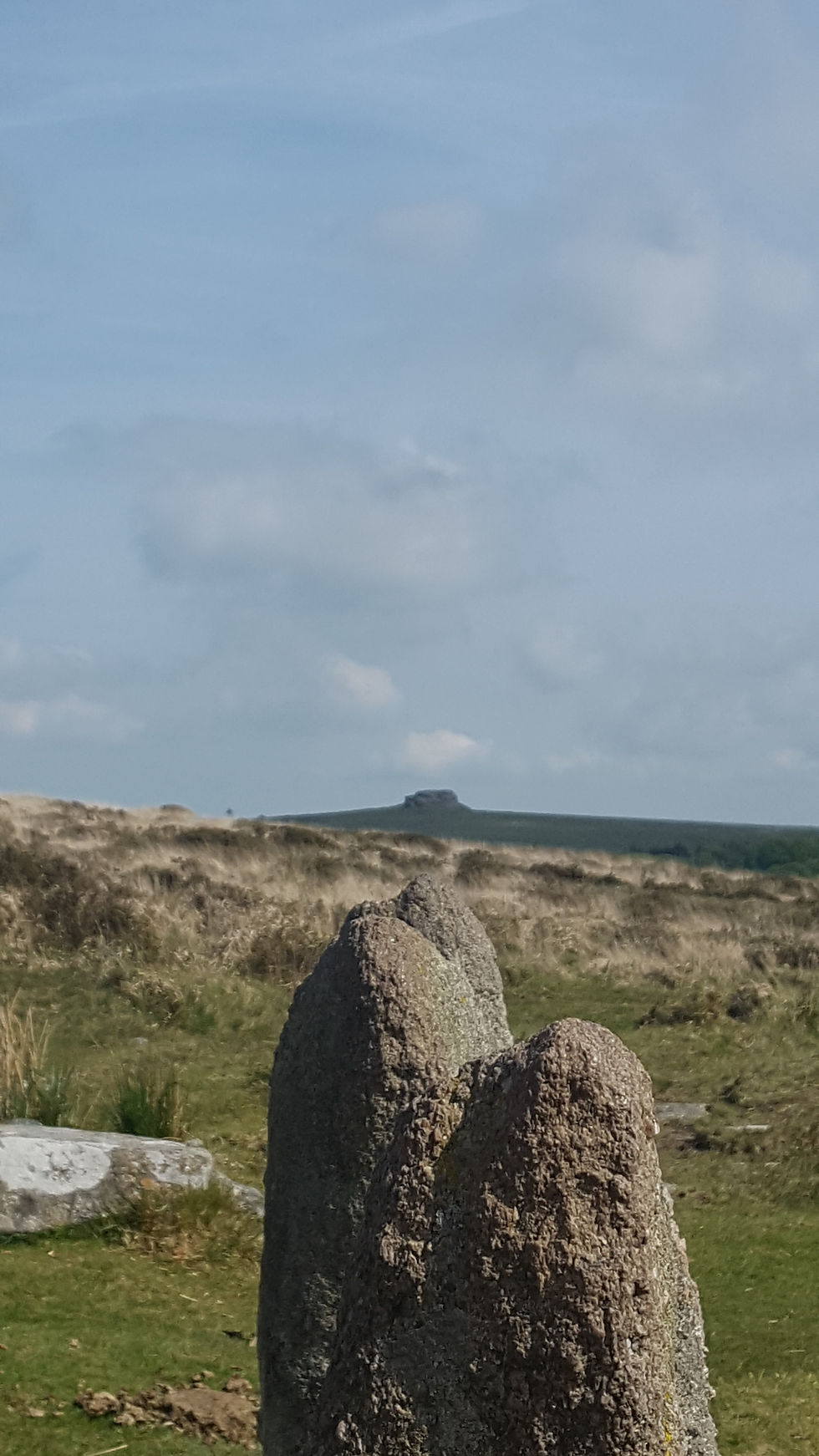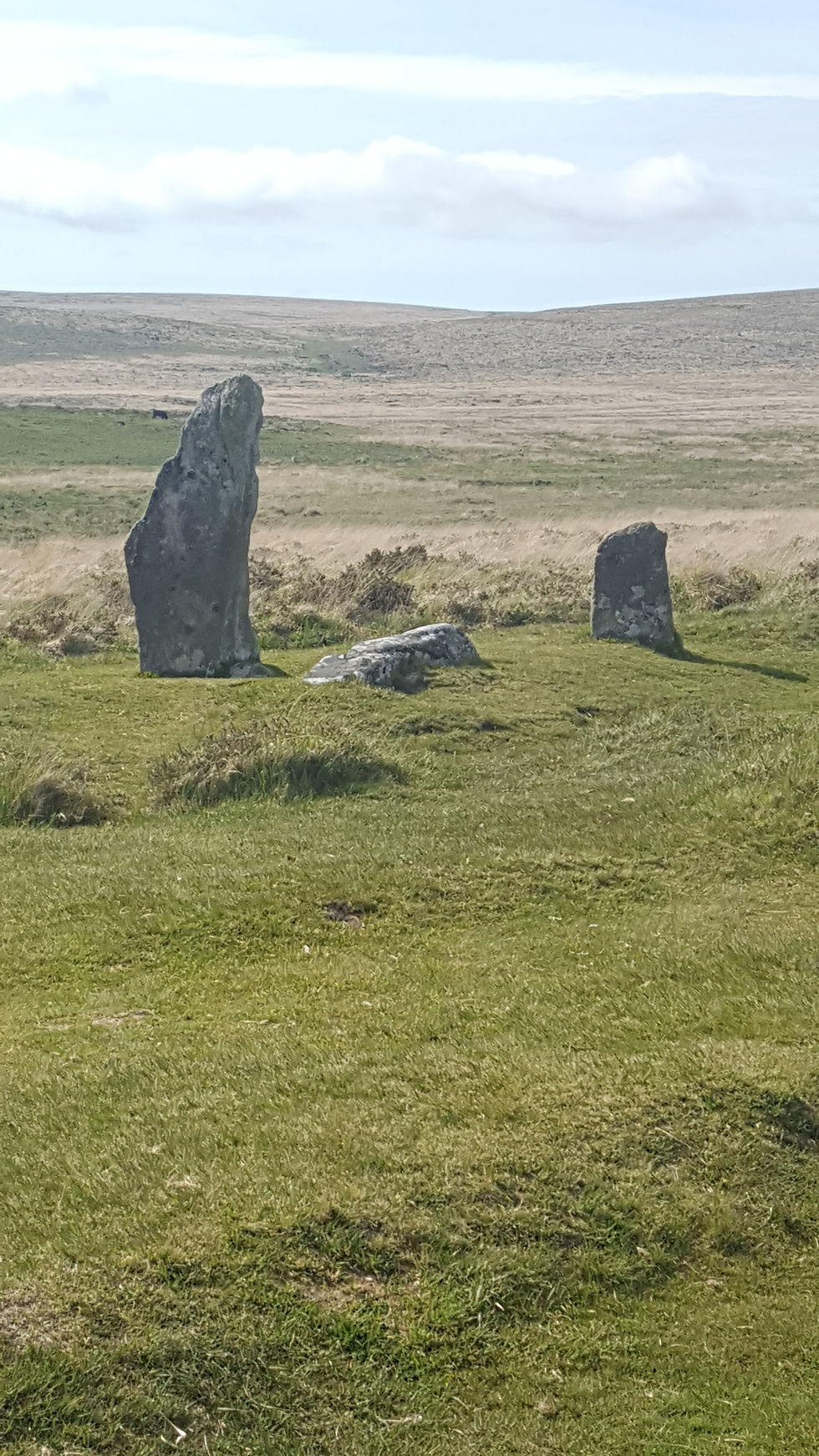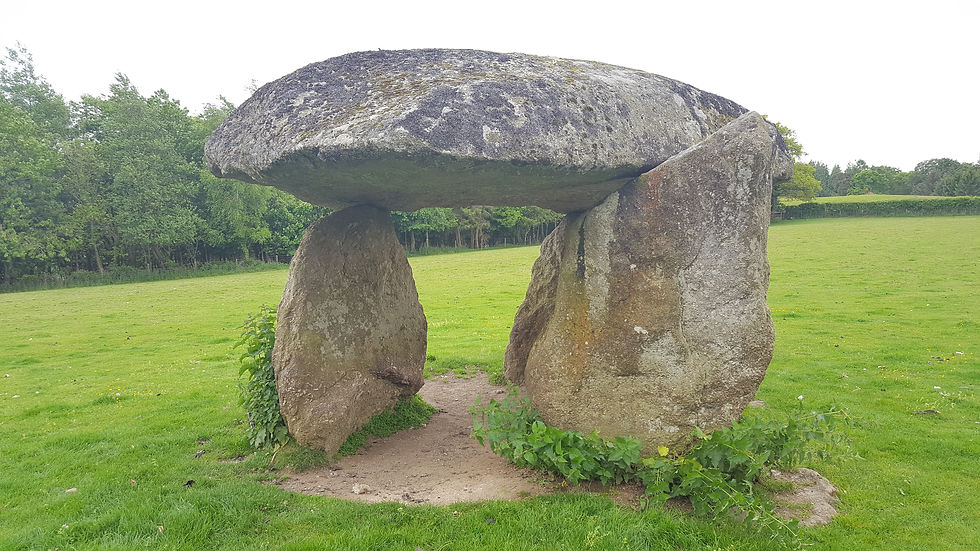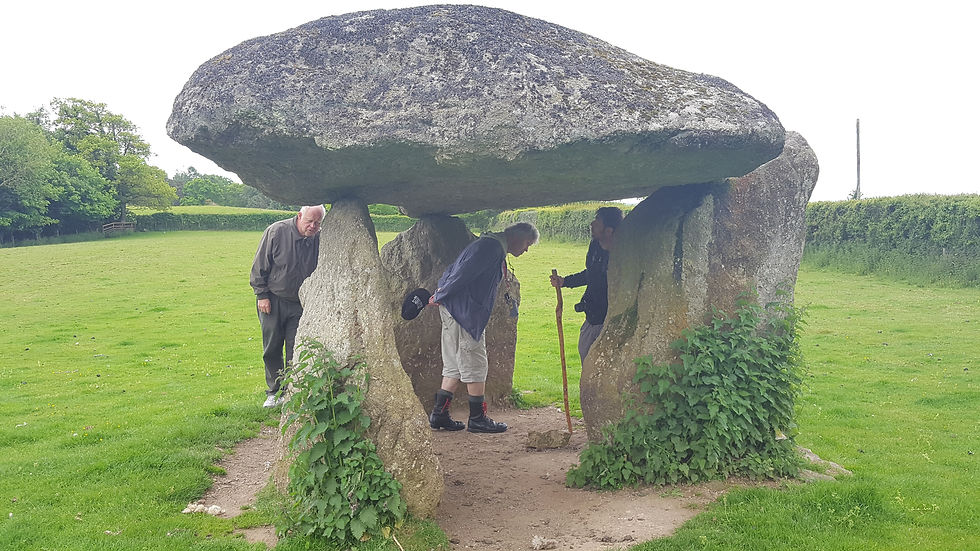EXMOOR & DARTMOOR TOUR DAY 4 WITH MEGALITHOMANIA. 22ND MAY 2017
- Gavin Dow
- Jun 11, 2017
- 11 min read
Monday arrived, another beautiful sunny morning. After getting sorted we drove down to Glastonbury to meet the megalithomania crew at the car park beside the town hall. Some had started to arrive already. We got out and chatted until the full team had arrived, things got sorted between the guides and drivers who had two mini buses. I took my car only because I could smoke in it and I like my space. We set off for a place called the Tarr steps, a megalithic stone walkway across the river Barle set down in the Barle valley nature reserve within the countryside of Exmoor. I followed the two buses out of Glastonbury where shortly after we lost the first bus. The driver we were following hadn't seen the first bus take a right turn. We followed this bus for a few hours around the countryside obviously lost, I ended up losing this bus somewhere also! So now we were on our own in the middle of nowhere. Four and a half hours it took us to arrive at our first destination where I was sure the others had been and gone. I wanted to go straight to our second point but Chris in his wisdom suggested we stop for a time. It had been a journey that tested our patience and tolerance, at one point I remember the feeling of being totally out place here in this beautiful countryside. This first part of the journey I could liken to David bowie' s labyrinth film these roads put his maze to shame, the roads are smooth and nice to drive, these are pretty much single-track roads with few passing places. The wheels of my car met both sides of the well-manicured grass banking’s that went near vertical about five feet with another 5 or 6 feet of hedging on top. After hours on these lonely roads I came across a tractor and trailer with a quad bike behind it. I immediately became aware of my surroundings and that I was going to have to reverse somewhere! Then the trees and the banking closed in on me, this is when I realized how out of my comfort zone I was. I can do single track roads on mountainsides in Scotland but this was altogether different. I remembered passing a field entrance what seemed at the time miles away, I tried not to panic but after only reversing one or two car lengths I was up on the banking, coming forward I try again! And again! I go up the banking, 3 times before I reached the point in the road where the farmer might get passed. (I would guess with the thoughts of ""Bloody tourists"“) in his head. Yes, we needed to stop, Chris was right! As we drove in to the small car park at Tarr steps we saw the first mini bus parked up. Great! they are still here. We walked down a gorgeous valley of fields and trees to the river Barle where we met the first team we had lost in the begining. The Tarr steps and river were bathed in sunlight, pebbles shone a myriad of colours no more than a foot under the water. This was a Ford still in use, a couple of jeeps went over during our nice but short time here.
( The ancient bridge of Tarr Steps is a well-known visitor attraction but the beautiful wooded valley of the River Barle is also worth exploring for its wildlife. Combined with the heathland of Winsford Hill and its wild ponies, this makes a varied walk. Tarr Steps is a 17 span clapper bridge (a bridge made of unmortared stone slabs), the longest of its kind in Britain. It was first mentioned inTudor times but may be much older. The river has silted up over the last century and often now comes over the stones in times of flood. The bridge has had to be repaired several times as stones of up to two tonnes have been washed up to 50 metres downstream. Map on link below.
http://www.exmoor-nationalpark.gov.uk/…/tarr-steps-from-dul…
The Tarr Steps are a clapper bridge across the River Barle in the Exmoor National Park, Somerset, England. They are located in a national nature reserve about 2.5 miles (4 km) south east of Withypool and 4 miles (6 km) north west of Dulverton.
A typical clapper bridge construction, the bridge's listing assesses it as medieval in origin. The stone slabs weigh up to two tons each. According to local legend, they were placed by the devil to win a bet. The bridge is 180 feet (55 m) long and has 17 spans. It has been designated by English Heritage as a grade I listed building and Scheduled Ancient Monument
https://en.wikipedia.org/wiki/Tarr_Steps )
We heard that the mini bus we were following was still out there somewhere ""poor folks"" I thought as my own journey earlier came to mind. At least now I had someone to follow. We got back on the road, our next place on the list was to be Scorhill stone circle on the edge of the Dartmoor countryside. We arrived sometime later at Scorhill carpark where we were to be greeted by peter knight and sue who had been patiently waiting on our arrival. We spent a wonderful hour and a half or thereabouts at this mysterious megalithic stone circle. After looking around and taking some photos I joined back up with peter who was speaking of a particular stone they were at, this was a feminine stone and had certain properties that it would bestow on anyone willing to sit in her energy. Well I'm all up for healing and gifts from mother gaia and needed to sit down anyway, I would sit here and lean my back against the stone facing into the circle. I closed my eyes and drifted in this peaceful place coming back round to wakefulness only to look at the landscape and stop myself from going too deep within the earth around me. Time passed and I came around to a cooler breeze than when I sat down, we headed back soon after.
‘These cryptic stones are my life. I want to get the secret of them or find at least a little of it. What are these lonely rings? Where are we standing now? In a place of worship, where men prayed to the thunder and the sun and stars? Or a council chamber? Or a court of justice that has seen many a doom pronounced, much red blood flow? Or is it a grave? Tis the fashion to reject the notion that they represent any religious purpose; yet I cannot see any argument against the theory. I go on peeping and prying after a spark of truth. I probe here (Scorhill Circle), and in the fallen circle yonder towards Cosdon; I follow the stone rows to Fernworthy; I trudge again and again to the Grey Wethers – that shattered double ring on Sittaford Tor. I eat them up with my eyes and re-people the heath with those who raised them. Some day a gleam of light may come. And if it does, it will reach me through deep study on those stone men of old.‘, (Phillpotts, 1903, pp. 281 -282).
What prophetic words and one which I am sure many people will share. That actual extract came from Phillpotts’ novel, ‘Children of the Mist’ and is a conversation held at Scorhill Circle. Some writers have described this Bronze Age feature as being, ‘The Stonehenge of Dartmoor’ whilst earlier topographers refer to it as Gidleigh Circle. Gidleigh Circle was certainly the first name to appear on the early OS maps as can be seen from the example from 1887 opposite. The etymology of the latter name is easy to explain, the circle sits on Gidleigh Common which in turn takes its name from the nearby village and parish of Gidleigh. However, Scorhill is a different matter, there is no reference to the name in any of the usual tomes but one possibility is that the Scor element derives from an old Norse word meaning ‘steep’? Either way, Gidleigh, Scorhill or Steep Hill Circle the name refers to a Bronze Age stone circle that appears as follows in 1830:
‘The Gidleigh circle consisting of stones, which are for the most part pointed, presents a very different aspect from the Grey Wethers. They are thirty-seven in number, ten of which are fallen. The highest of those in their original position, is eight feet above the ground; the medium height of the largest number is about four feet and a half, the smallest stone is three feet. Diameter of the circle, ninety feet.’, (Rowe, 1830, p.183).
http://www.legendarydartmoor.co.uk/scorhill.htm
( Scorhill is situated in a landscape of megalithic monuments and features in local stories about horses unwilling to pass through the circle. Some folklore links it to The Tolmen, a stone with a large, donut-shaped hole in it, overhanging a nearby stream. One story of the "faithless wives and fickle maidens" tells the tale of unfaithful women being made to wash themselves in a nearby pool, run around Scorhill three times and then pass through the Tolmen and pray in front of the stones for absolution. Unforgiven women were crushed by a stone, giving the eerie suggestion as to why so many stones have fallen. ) Flint artefacts from around the site on Gidleigh Moor date as far back as 8500 BC during the Mesolithic period and are now held at Torquay Museum.
https://en.wikipedia.org/wiki/Scorhill
We got back to the car park where we said our goodbyes to peter and sue who were now going to wait on the second mini bus to arrive or not! It would definitely be cooler for them as the damp cooler air came in behind us as we were leaving the open moor. We had been traveling a short distance when we bumped into the second bus I was following and lost earlier on that day. It was around 5.30pm and I'm sure there was a few tired souls on that bus, it had held most of the party. The drivers exchanged directions, the carpark where peter and sue were waiting was less than a mile away they would be there soon. We went onto our next site called Spinsters rock a megalithic dolmen which was situated in a farmer’s field only a few miles away. We stopped on the road and I got out as Hugh got out the bus (I reckoned we were lost again) lol. We both got onto a gate and looked over for any sign of the stones, we had drove upwards and were now sitting high on the landscape, looking around from this vantage point I could see the surrounding area, a breath of fresh air it was to see more than two or three hundred meters in any direction at any given time, hours had passed driving these tiny neat roads with high banking’s at either side. Wow what a view. We had already passed spinsters rock and found it back down the road we had come up. When we arrived at Spinsters rock it sat further down a field that some sheep were grazing in. What an amazing site to see this structure sitting in the middle of this field protected by trees that grew along its perimeter. I had not seen anything like this before, I have saw many on the internet but I had not yet come in person to one before.
( In a field due north of Chagford off a minor road leading to the village of Drewsteignton there stands an unusual structure consisting of a large stone slab or capstone supported by three upright stones. This is Spinster's Rock, the best surviving example in Devon of a neolithic burial chamber known as a dolmen or cromlech. Three stones are necessary and sufficient to support the capstone of a dolmen, though instances of these megalithic antiquities with more than three supports exist. Now, as a general rule under such circumstances, three points of support, and three only, will be found to be effective; hence any of the enclosing stones can be removed, provided that three are left so placed that the centre of gravity of the capstone falls within the triangle formed by their points of contact with it. [R Hansford Worth, p468] The word dolmen is derived from the Celtic words daul, a table, and maen, a stone. Typically dolmens were covered with earth or smaller stones to form a barrow which in this case has weathered away, leaving only the stones of the burial mound intact. When first mapped by archaeologists Spinster's Rock was surrounded by a number of other stones arranged in circles and rows which may have been added after the dolmen was erected, but these have now disappeared. The dolmen's name derives from the legend that three spinster's had time to kill one morning before breakfast while waiting for the jobber to call and collect the woollen cloth they had spun. These indefatigable wool-spinners, who were not spinsters in the unmarried sense, decided to while away the time by artfully balancing a few large stones in an upright position. The first written account of this legend referring to Spinster's Rock was by William Chapple who in 1778 interrupted his work on the preparation of a "correct" version of Tristram Risdon's Survey of Devon to write a book about this antiquity. Unfortunately he died the following year before either book was published, though the manuscript concerning the cromlech was already in the hands of a printer. They produced an advertisement to promote this book that referred to the supposed Druidical significance of the dolmen; the italicised part is the book's full title: The Description and Exegesis of a very remarkable Cromlech, hitherto preserved entire, on Shilston Farm, in the parish of Drewsteignton, Devon: Demonstrating the surprising accuracy of its geometric and astronomic construction; ascertaining its antiquity and primary use; and examining how far it might become accidentally subservient to the superstition of the Druids, and to what purposes afterwards applied by the Romans, or by some Romanized Britons and Pagan Saxons.)
http://www.devonperspectives.co.uk/spinsters_rock.html
https://en.wikipedia.org/wiki/Spinsters%27_Rock
This dolmen consisted of three standing stones and a cap stone. They are encrusted with masses of quartz crystals of various shapes and sizes, stunning it was to see these glittering pieces of highly charged crystal cover the full structure. I went in and stood in the middle where I felt a powerful electromagnetic field push my full body in on itself, I was being squeezed by an invisible force. This really blew my mind. I can pick up on and even see energies at times and thought I knew what it was all about lol. I wasn't ready for this. I said to Hugh as he came under "can you feel that”? He replied that his legs were tingling and mentioned the type of energy therein, piezoelectric energy I think he called it. I called it amazing. We spent maybe 30 min here climbing and taking photos I could have stayed for hours buzzing in this place. It would have been nice to drum or better still use the crystal singing bowls inside Spinsters rock. Maybe next time!
Monday's tour had come to an end. We parted company with the bus and headed towards Okehampton only 10 miles away. Chris and I had been invited for lunch by his friends who lived in this small town. We traveled down a short dual carriageway that felt like heaven to be out of the labyrinth of roads that crossed the Exmoor and Dartmoor countryside. When we arrived, we were greeted with smiles and a hug from Rebecca & Wenna, it was nice to be in their company Shane, Rebecca’s partner was away working further north and couldn't be there. Rebecca had laid a whole table out with all kinds of wonderful food for us to eat, after the long day I had I was only able to manage a coffee which Rebecca made especially strong for me, well I needed this and as Chris proceeded to eat his way through everything on the table, I guess he needed that too lol. We spoke for a time sharing who we were and speaking of a wedding ceremony Chris would be doing for them both in the summer of this year 2017. To be asked to perform such a marriage ceremony is a great privilege and Chris is full of excitement for it. I could probably perform ritual ceremony sending someone into the afterlife with ease but to do a marriage ceremony would be a totally other thing. Chris has no worries about this lol I'd be panicking or in Scottish slang { Shite-ing masell }. We spent about an hour and a half with them both and left happy with our short stay. It was around 9pm and we had a long drive back to camp, it was not long before we were back on the dual carriageway or motorway can’t remember but it was a massive road compared to the ones driven all day. We arrived back at camp about 10.30 pm. Where I had coffee, and looked over to the familiar fields I see each day. I was glad to get back! It had been a long eventful day with some powerful emotions and energies experienced throughout. Although it was a bit crazy at times, in the end it was a great day full of gifts and healing. The stars again were bright that night it was approaching or just gone by the new moon. I fell into another peaceful sleep with the sound of the screeching and hooting of the owls. The highlight of this day was for me Spinsters rock, an amazing thing to see and experience, a place to get
















out on free energy.
Love & light































Comments